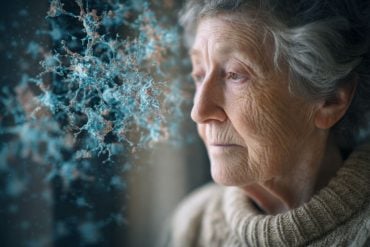Summary: Yoga intervention reduces symptoms of depression and anxiety while increasing feelings of positivity.
Source: Boston University School of Medicine
Scientific studies already support yoga practice as a means to reduce symptoms of depression and anxiety. Now a new study out of Boston University School of Medicine (BUSM) provides evidence that yoga and breathing exercises can improve symptoms of depression and anxiety in both the short term–with each session as well as cumulatively in the longer term, over three months.
Published online in the Journal of Psychiatric Practice, these findings suggest yoga can be a helpful complementary treatment for clinical depression or major depressive disorder.
A group of 30 clinically depressed patients were randomly divided into two groups. Both groups engaged in lyengar yoga and coherent breathing with the only difference being the number of instructional and home sessions in which each group participated. Over three months, the high-dose group (HDG) spent 123 hours in sessions while the low-dose group (LDG) spent 87 hours.
Results showed that within a month, both groups’ sleep quality significantly improved. Tranquility, positivity, physical exhaustion and symptoms of anxiety and depression significantly improved in both groups, as measured by several validated clinical scales
“Think of it this way, we give medications in different doses in order to enact their effects on the body to varying degrees. Here, we explored the same concept, but used yoga. We call that a dosing study. Past yoga and depression studies have not really delved deeply into this,” explained corresponding author Chris Streeter, MD, associate professor of psychiatry at BUSM.
“Providing evidence-based data is helpful in getting more individuals to try yoga as a strategy for improving their health and well-being. These data are crucial for accompanying investigations of underlying neurobiology that will help elucidate ‘how’ yoga works,” said study collaborator and co-author Marisa M. Silveri, PhD, neuroscientist at McLean Hospital and associate professor of psychiatry at Harvard Medical School.

Depression, a condition that affects one of every seven adults in the U.S. at some point in their lives, is treated with a variety of modalities, including counseling (especially through cognitive-behavioral therapy) and medication. Research has shown combining therapy and medication has greater success than either treatment alone. Although studies with more participants would be helpful in further investigating its benefits, this small study indicates adding yoga to the prescription may be helpful.
Funding: Funding for this study was provided by grants R21AT004014 and R01AT007483 (CCS), M01RR00533 from the Boston University Clinical and Translational Science Institute (CTSI), and U11RR025771 (General Clinical Research Unit at Boston University Medical Center) and K23AT008043 (MBN).
Drs. Brown and Gerbarg teach and have published Breath-Body-Mind©, a multi-component program that includes coherent breathing. Dr. Streeter is certified to teach Breath-Body-Mind©. The other authors declare no conflicts of interest.
Source:
Boston University School of Medicine
Media Contacts:
Gina DiGravio – Boston University School of Medicine
Image Source:
The image is in the public domain.
Original Research: Closed access
“Psychological Function, Iyengar Yoga, and Coherent Breathing: A Randomized Controlled Dosing Study”. Chris Streeter at al.
Journal of Psychiatric Practice doi:10.1097/PRA.0000000000000435.
Abstract
Psychological Function, Iyengar Yoga, and Coherent Breathing: A Randomized Controlled Dosing Study
Background: Evidence suggests that yoga may be an effective treatment for major depressive disorder (MDD). Studies evaluating the “dosing” of yoga treatment and efficacy for MDD are needed. The goal of this study was to assess the effects of an intervention combining Iyengar yoga and coherent breathing in participants with MDD and determine the optimal intervention dose.
Methods: Thirty-two participants (18 to 65 y of age) diagnosed with MDD were randomized to a high-dose group (HDG) or a low-dose group (LDG) of yoga and coherent breathing for 12 weeks. The HDG (n=15) involved three 90-minute yoga classes and four 30-minute homework sessions per week. The LDG (n=15) involved two 90-minute yoga classes and three 30-minute homework sessions per week. Participants were evaluated at baseline, week 4, week 8, and week 12 with the following instruments: Positivity Self-Test, Spielberger State Anxiety Inventory, Patient Health Questionnaire-9, Pittsburgh Sleep Quality Index, and Exercise-induced Feeling Inventory. Data were analyzed using intent-to-treat methods.
Results: Significant improvements in all outcome measures were found for both groups, with acute and cumulative benefits. Although the HDG showed greater improvements on all scales, between-group differences did not reach significance, possibly due to lack of power because of the small sample size. Cumulative yoga minutes were correlated with improvement in outcome measures.
Limitation: This dosing study did not include a non-yoga control.
Conclusions: Improvement in psychological symptoms correlated with cumulative yoga practice. Both interventions reduced symptoms of depression and anxiety and increased feelings of positivity. The time commitment for yoga practice needs to be weighed against benefits when designing yoga interventions.






